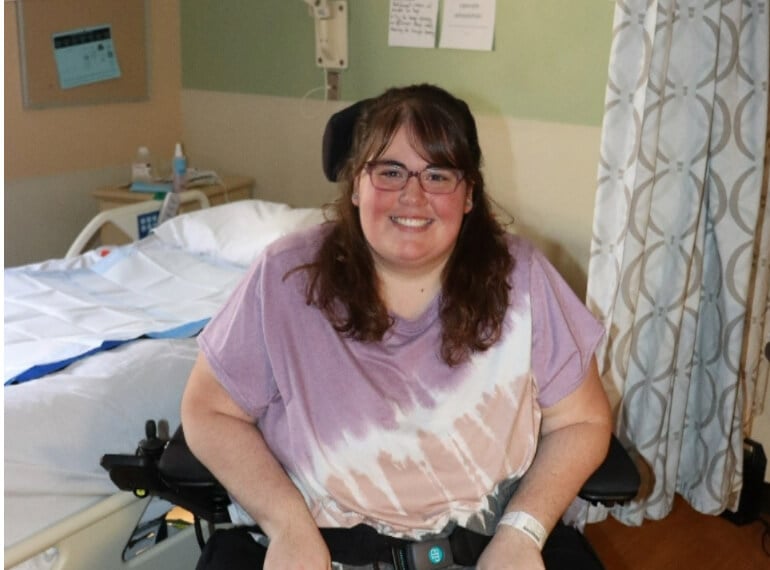Ashley's story

Ashley Ahearn's hospital experiences were rare. She had never broken a bone or dealt with a serious illness. However, life took an unexpected turn when she was diagnosed with a rare neurological disorder.
One winter day, the middle school teacher sensed something was "off," initially thinking it was just a stomach bug. As days passed, her symptoms worsened. The once-normal routine of coming home from work and cooking dinner became a challenge. Severe weakness and numbness gripped her legs, leading her to the emergency room at Newton Medical Center.
What followed was a three-week battle to regain her health. After extensive tests like spinal taps, CT scans, MRIs, and x-rays, doctors revealed Ashley had Guillain-Barre syndrome – a condition where the immune system attacks the nervous system, causing weakness and, in some cases, paralysis. While her condition stabilized, she found herself without the ability to walk or stand. "I had zero strength in my legs and very little in the arms," she recalled.
Despite these daunting challenges, Ashley's determination to overcome was steadfast. She opted for Kessler Institute for Rehabilitation – Chester, seeking the focused treatment she needed. Starting with needing maximum assistance just to get into a wheelchair or carry out daily self-care tasks like dressing, bathing and eating, Ashley held tight to her goal: "My goal is to walk again and come home. I told them on day one, I wanted to get back to the normal."
The team at Kessler, led by physicians, nurses and neuro-rehabilitation experts, designed a tailored plan to meet Ashley's goals. She dedicated herself to each therapy session, promising to never turn down a challenge. "I'll never say no. I can't promise it'll work, but I'll never say no to trying something," she affirmed.
She steadily improved her strength, coordination, balance and endurance and worked with her physical therapists on gait training. Ashley used the Barihab mat — a tool that converts from a mat table to a seat to a standing frame — to improve her sitting balance and ability to stand independently. Even though she did not enjoy using it, she knew it would help in her recovery. “The first time I did it, I just looked like I was hanging over it, I couldn’t hold on … I just hated that feeling but we still did it all the time and it did help. That’s for sure,” she said.
She also used the Erigo — a tilting device that combines gradual virtualization with robotic movement therapy — to address the pain in her left leg. The Andago, a body-weight supported gait training system, further boosted her endurance. Ashley's hard work culminated in a triumphant moment when she walked with a rolling walker, shedding the reliance on machines. "No more machines, it was just me and the walker and I was in charge of it," she proudly stated. Nearly six weeks of dedication later, she achieved the milestone of walking 150 feet with the walker and taking four steps using handrails.
Ashley's occupational therapists also played a pivotal role in her recovery, improving her hand function and ability to handle daily activities. They introduced her to adaptive tools like a reaching aid and dressing stick. She even utilized technology like the Bioness Integrated Therapy System to work on her balance and skills she'd use as a teacher. Gradually, she gained independence in tasks like bathing and dressing.
Ashley recalled how much the therapy services and support from her Kessler care team affected her progress. “I couldn’t have asked for a better team,” she said. “Everybody there was great. They listened to you and constantly motivated you and I think that was a big reason why I got to where I was.”
Throughout her journey at Kessler, Ashley's family provided steadfast support through calls and visits. Her parents actively engaged in family training sessions with her therapists, witnessing her progress firsthand. The contrast from her initial visit to subsequent ones was remarkable.
Upon discharge, equipped with techniques and tools, Ashley felt ready for a safe transition home. She had a drop arm commode, a hospital bed, a rolling walker and a specialized wheelchair. Her commitment to rehabilitation continued at home, where she maintained her exercises. "I'm still doing my exercises and I still know what to do ... it's just like learning how to do it on my own now," she explained.
For those facing similar challenges, Ashley offers words of encouragement: "Even the hardest things you can overcome ... even if it doesn't seem like it."